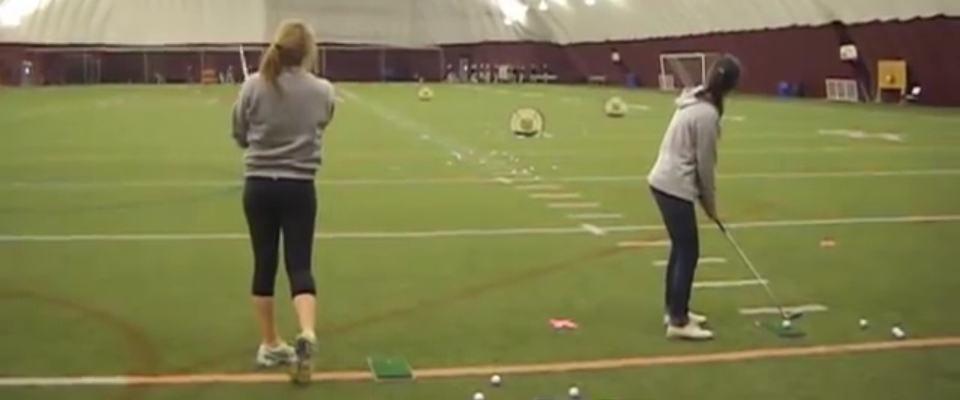GOLF
Posture Means Power
From Complete Conditioning for Golf by Peter Draovitch, Wayne Westcott
Believe it or not, posture has a positive influence on power production. Just as it is impossible to run fast without proper posture, it is unwise to swing a golf club without appropriate postural stability. Functional posture makes a world of difference in your swinging action and lets you impart far more force in your ball strike. For a simple demonstration, try sitting slumped in a chair with your head pushed forward. Now try to raise your arm. Now try to turn your head to the left, as you would have to do during the backswing. Now try to turn your body to the right. Next, sit up straight with your chin pulled in and your back slightly arched. Repeat the above motions and then decide which posture produced a greater range of motion.
Body structure and posture are individual characteristics, but an improper golf swing can cause certain muscle imbalances. These imbalances might not be obvious until they cause a disruptive physical problem. Some common physical limitations include:
-Reduced neck rotation can make it difficult to keep your eye on the ball during the swing.
-Insufficient trunk strength interferes with your ability to transfer forces from the lower body to the upper body. In addition, proper spine angle will not be maintained during the swing.
-Tight hamstrings do not allow an effective address position to be achieved.
-Reduced range of hip motion leads to compromised swing patterns.
-Decreased trunk rotation limits shoulder turn and causes poor sequencing between the hips and trunk region.
-Insufficient shoulder strength, especially in the rotator cuff, leads to decreased club head speed, as well as poor deceleration and club control.
Many players think of these problems as a mere product of the sport and resort to anti-inflammatory medication and other quick-fix alternatives. These responses might reduce pain temporarily, but they rarely solve the underlying problem. Most postural conditions do not occur overnight. The body slowly adapts to poor posture, and some body parts, like the neck, shoulder, back, and hip, may be overused to compensate for loss of motion someplace else. By performing a few simple exercises regularly, however, you can improve and maintain good posture and thereby improve your swinging power.
The ability to maintain your functional trunk position for each shot is an acquired skill. Teaching pros commonly refer to this position as maintaining spine angle. When the spine is stable it serves as an efficient and rigid lever to transfer energy from the lower body to the upper body. By increasing the stability of the spine and the muscles that support it, you therefore can improve your game.
Bending the spine places unnecessary stress on the lower back muscles and joints. It also reduces your ability to transfer power from your lower body to your upper body, which translates into decreased club head speed. For example, when your upper back is bent forward or hunched over, you place extra stress on your shoulders and neck as your shoulders round forward, thereby causing the rotator cuff muscles (a group of four small muscles that protect the shoulder joint) to work in an abnormal position. This undesirable posture can produce tendonitis, muscle strain, and joint sprain by placing the muscles at a mechanical disadvantage. Of course, this position also limits your swing action to a portion of the potential movement range.
Postural muscles (the muscles that maintain spine angle) are found throughout the body and function more for endurance than for strength or power. The main role of these muscles is to hold the skeletal system and joint structures in proper alignment so the larger and stronger muscles can produce the desired body movements with appropriate forces in tandem with keeping good balance.
If you ever stood at the loop at St. Andrews and felt the wind blow, you know the importance of balance. Balance is one of the golfer’s key fitness components. The balancing interactions of the body represent a complex communication system. Balance is controlled by the central nervous system, the eyes, the inner ear, and tiny message receptors in the joints and soft tissues. When the ball lies uphill, downhill, level or side hill, above or below the feet, poor balance definitely can contribute to a poor shot from an imperfect lie. If we combine these factors with an inability to maintain proper trunk position throughout the swing, we increase both the probability of a poor shot and a physical injury. The goal of the postural exercise program is to improve both static and dynamic balance for the purpose of developing functional stability during the swing.
Posture Means Power
From Complete Conditioning for Golf by Peter Draovitch, Wayne Westcott
Believe it or not, posture has a positive influence on power production. Just as it is impossible to run fast without proper posture, it is unwise to swing a golf club without appropriate postural stability. Functional posture makes a world of difference in your swinging action and lets you impart far more force in your ball strike. For a simple demonstration, try sitting slumped in a chair with your head pushed forward. Now try to raise your arm. Now try to turn your head to the left, as you would have to do during the backswing. Now try to turn your body to the right. Next, sit up straight with your chin pulled in and your back slightly arched. Repeat the above motions and then decide which posture produced a greater range of motion.
Body structure and posture are individual characteristics, but an improper golf swing can cause certain muscle imbalances. These imbalances might not be obvious until they cause a disruptive physical problem. Some common physical limitations include:
-Reduced neck rotation can make it difficult to keep your eye on the ball during the swing.
-Insufficient trunk strength interferes with your ability to transfer forces from the lower body to the upper body. In addition, proper spine angle will not be maintained during the swing.
-Tight hamstrings do not allow an effective address position to be achieved.
-Reduced range of hip motion leads to compromised swing patterns.
-Decreased trunk rotation limits shoulder turn and causes poor sequencing between the hips and trunk region.
-Insufficient shoulder strength, especially in the rotator cuff, leads to decreased club head speed, as well as poor deceleration and club control.
Many players think of these problems as a mere product of the sport and resort to anti-inflammatory medication and other quick-fix alternatives. These responses might reduce pain temporarily, but they rarely solve the underlying problem. Most postural conditions do not occur overnight. The body slowly adapts to poor posture, and some body parts, like the neck, shoulder, back, and hip, may be overused to compensate for loss of motion someplace else. By performing a few simple exercises regularly, however, you can improve and maintain good posture and thereby improve your swinging power.
The ability to maintain your functional trunk position for each shot is an acquired skill. Teaching pros commonly refer to this position as maintaining spine angle. When the spine is stable it serves as an efficient and rigid lever to transfer energy from the lower body to the upper body. By increasing the stability of the spine and the muscles that support it, you therefore can improve your game.
Bending the spine places unnecessary stress on the lower back muscles and joints. It also reduces your ability to transfer power from your lower body to your upper body, which translates into decreased club head speed. For example, when your upper back is bent forward or hunched over, you place extra stress on your shoulders and neck as your shoulders round forward, thereby causing the rotator cuff muscles (a group of four small muscles that protect the shoulder joint) to work in an abnormal position. This undesirable posture can produce tendonitis, muscle strain, and joint sprain by placing the muscles at a mechanical disadvantage. Of course, this position also limits your swing action to a portion of the potential movement range.
Postural muscles (the muscles that maintain spine angle) are found throughout the body and function more for endurance than for strength or power. The main role of these muscles is to hold the skeletal system and joint structures in proper alignment so the larger and stronger muscles can produce the desired body movements with appropriate forces in tandem with keeping good balance.
If you ever stood at the loop at St. Andrews and felt the wind blow, you know the importance of balance. Balance is one of the golfer’s key fitness components. The balancing interactions of the body represent a complex communication system. Balance is controlled by the central nervous system, the eyes, the inner ear, and tiny message receptors in the joints and soft tissues. When the ball lies uphill, downhill, level or side hill, above or below the feet, poor balance definitely can contribute to a poor shot from an imperfect lie. If we combine these factors with an inability to maintain proper trunk position throughout the swing, we increase both the probability of a poor shot and a physical injury. The goal of the postural exercise program is to improve both static and dynamic balance for the purpose of developing functional stability during the swing.

Golf Training on Long Island














